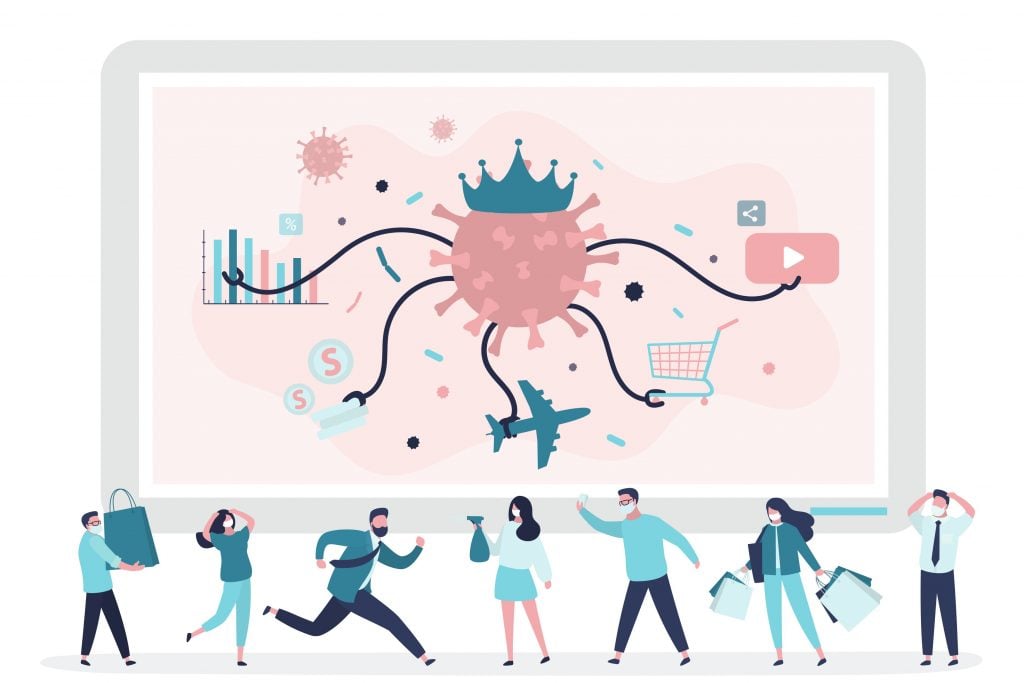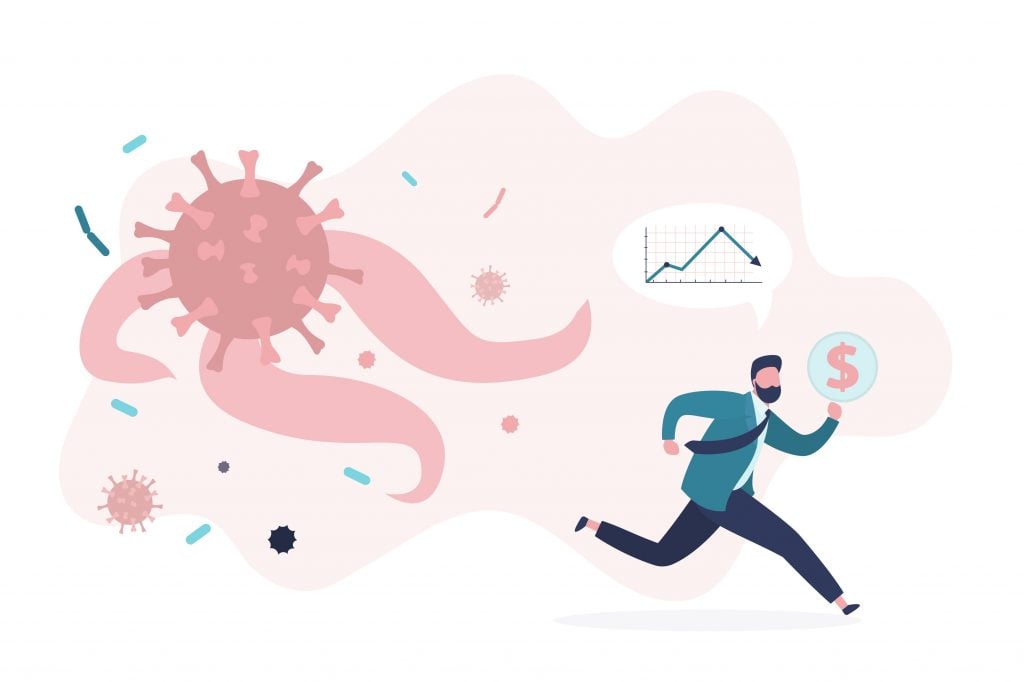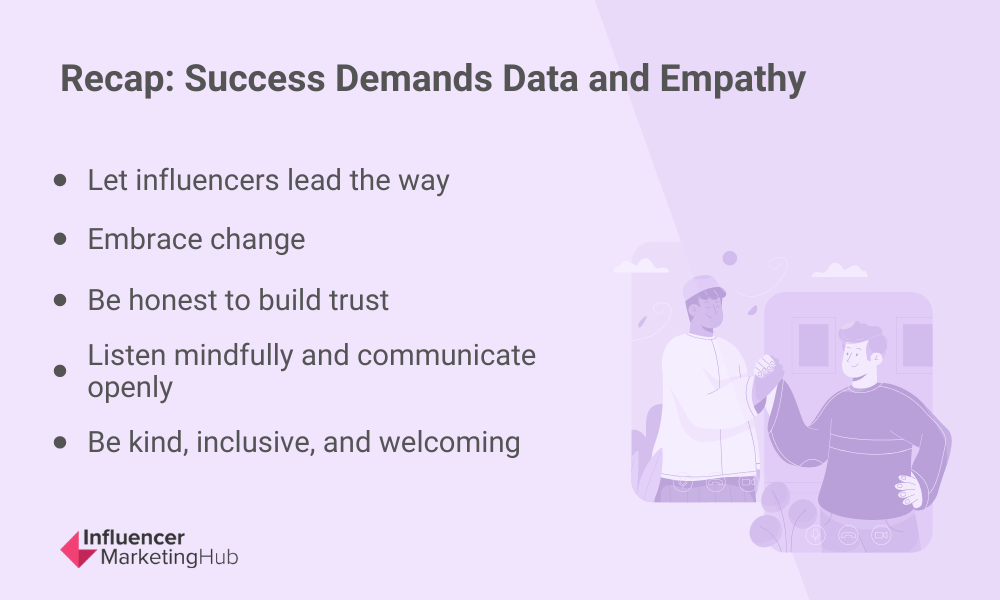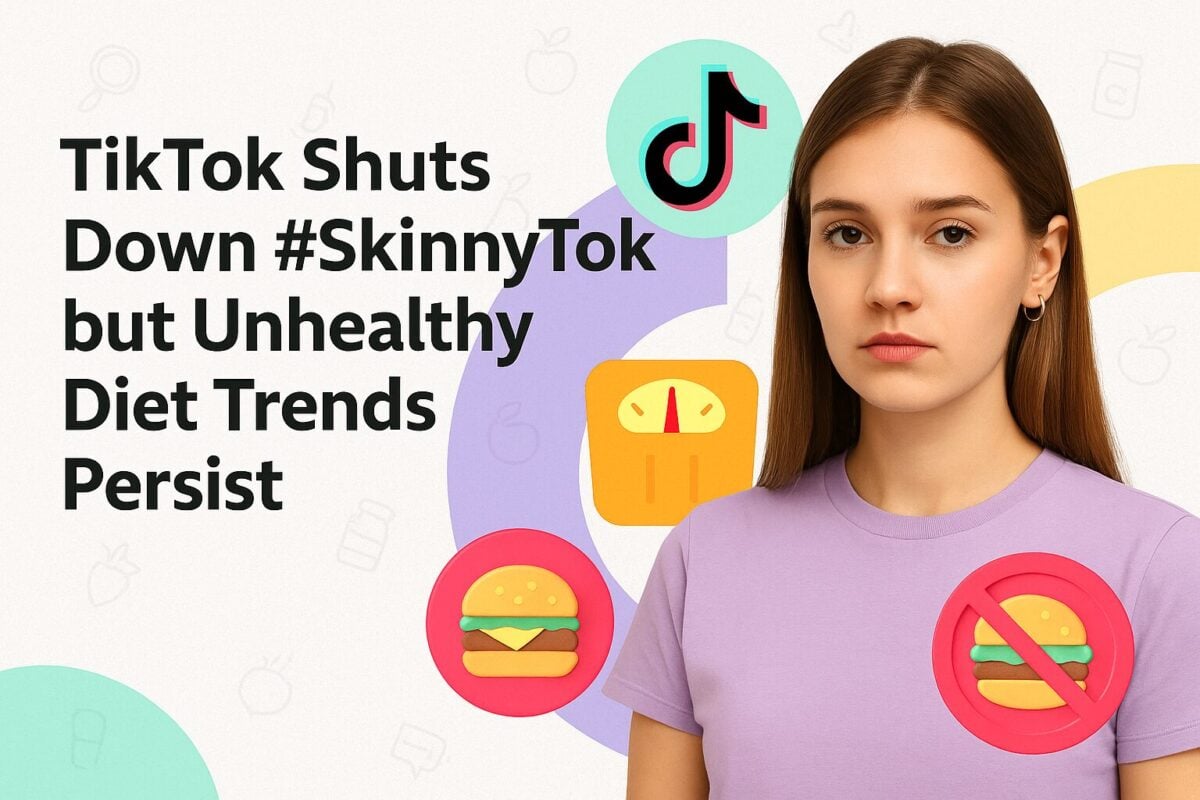As US COVID restrictions dissolve, and consumers are resuming the lives they put on hold over a year and a half ago, there’s never been a more hopeful outlook on the future of influencer marketing. Target audiences are eager to spend the money they saved during quarantine—big box brands like Home Depot saw a promising 61% same-store sales spikes year-over-year, and Macy's at a whopping 63%, according to Cheddar News. Travelers are booking the vacations they planned during lockdown, as Google searches for “passport appointment” have grown 300% since last year, and consumers are looking forward to making up for lost time. Marketers are now tasked with integrating the learnings of 2020 into “the new, new normal” of 2021: a highly-anticipated, socially non-distanced, mask-off world.
As Brands and Consumers Emerge From COVID, Influencers Lead The Way:
COVID Era: Consumers Turned to Influencers

When COVID changed everything about how consumers explore the world and engage with brands, social media marketers were quick to investigate how this new era would impact influencers and their communities. Across a multitude of verticals, they soon saw that social media audiences were spending more time than ever getting to know their favorite influencers, and discovering new ones to love. In fact, engagement has soared since lockdown began: on average, A&E reports that Instagram influencer accounts have seen a 67% increase in likes, and a 51% increase in comments. Quarantined at home for a seemingly endless amount of time and exhausting their favorite content on streaming services, consumers sought out social engagement to avert boredom. As a result, influencers became a source of both entertainment and social relationships. Suffice to say, influencer content became an important part of consumers’ mental wellbeing during the tumultuous time.
As 2021 progresses, influencers continue to become a more integral part of consumer media, and that growth has been heavily accelerated by COVID lifestyles. Throughout the pandemic, according to the Edelman Trust Barometer, there was a 50% spike in fear of fake news - people turned to social to escape and find joy. Thus, entertainment is no longer limited to the big screen, and has now become a social media staple: Hootsuite reports that 32% of consumers primarily use social media to find funny and entertaining content. As stated in PR Newswire, only 10% of Gen Z now turn to film and television as their primary source of entertainment, while the majority prefer spending time on the internet and social media. In fact, AdAge reports that in March 2021, influencer-driven channels reached more than double the amount of Gen Z consumers as television broadcast channels did. Social entertainment is even the primary draw of TikTok: the Harris Poll found that 71% of all TikTok users follow comedy influencers, who provide endless entertainment with the relatable content that consumers have craved since quarantine began. Audiences developed closer relationships with influencers not only to be entertained, but also to make authentic digital connections during a time of Zoom fatigue. As audiences sought out opportunities to virtually engage with people who bring value to their lives, influencers added a familiar, friendly atmosphere to the digital space, which transformed the way consumers use social media. And now, influencers are perfectly poised to carry the success they’ve earned into the bright future that’s just around the corner.
The Same Principles Still Apply
As each day brings the world closer to a post-COVID era, social media marketers must prepare their strategies to get ahead of competitors. Marketers had to adapt so much in 2020, but some things never change—great influencer marketing campaigns always start with data-backed strategies and brand-aligned influencers who create engaging content. Having access to in-depth, human-driven, nuanced insights is essential to efficiently scale the practice—which is where a strong SaaS partner like Julius can help marketers tell creative stories.
The foundation for a great campaign may remain the same, but the scaffolding will change as social media communities evolve. When the pandemic began, many influencers quickly recognized the need to adopt a new social media content strategy to fit with the cultural shift to stay at home. At the start of the pandemic, travel influencer Ana Linares (@ananewyork) transitioned to at-home photoshoots with more behind-the-scenes content showcasing her personal lifestyle, as reported by USA Today. “I had incorporated more home moments that are relatable to our current circumstance with the lockdown, but to my surprise, I have grown my audience during the pandemic,” she explains. “I have never seen my audience more engaged than they are now.” Her average engagement rate rose from 6% at the start of the pandemic to 8.25% in June 2020.
Additionally, many influencers have adjusted their content strategy to include more video in response to changing trends: Influence Central reports that coming out of COVID-era consumer engagement success, more than half of influencers aim to create more video content in the future as a direct response. Influencers aren’t the only ones who should pay attention to this—yes, marketers know that “video is king,” but COVID cemented its royal position more than ever before. During the pandemic, 66% of consumers went to YouTube first to learn about new products, according to Buzz Stream. Now that consumers have more time to research products while browsing their options online, video (and shoppable) content brings their experience as close to in-person retail as possible. These changes are an opportunity to meet consumers eye-to-eye and match their preferences—if you haven’t incorporated video into your social strategy yet, now is the time to adapt and commit.
Staying Ahead of “Normalcy”
While COVID has brought on new strategic challenges that will alter consumer engagement, storytelling, and other practical elements to influencer marketing, there are stalwart milestones that marketers must still reach in order to find success. In 2021 and beyond, quality research will be more vital than ever to hit the mark. With consumers’ gazes pulled to the screen (and in more directions than ever before), creating a long list of qualified partners will be crucial to running an efficient production. In reality, the challenge will be competition from other brands also vying for influencer partnerships, which is why you should start today and set thorough criteria. It will take time to research and begin building a list, which is why getting ahead of schedule is such a high priority. With the reanimation of many brands, there might be more bottlenecking than usual, and having safety nets of influencer options will help you in the long run so you won’t have to do more research later. Prioritize a high volume of brand-safe influencers in the early stages, and then refine from there as you decide what qualities will be best for the campaign. Finding the perfect influencer fit has never been more important. As influencer Nimi Blackwell (@nimiblackwell) tells Vamp in March 2021, “My followers feel more confident in the message that is being delivered because they can see it’s a brand I would genuinely promote.” Julius helps narrow down the search with parameters from influencer interests to audience demographics, in order to pinpoint influencers who perfectly match your brand’s criteria. Once you’ve filtered by these preferences, you’ll be able to scale down your sizeable list to a manageable number.
According to Digital Commerce 360, 51% of shoppers say that trust is their primary motivator for selecting who to shop with. In the era of COVID, influencers (and just about everyone else) value genuine and candid communication, which serves as the foundation for an honest and respectful relationship. Be truly authentic, and share your ideas for the campaign—even if it’s still just in the early stages of planning. If you approach them in the spirit of collaboration, you might be gifted with creative insights that can spark a whole new project inspired by the influencer’s own unique style. Since they have a proven ability to connect with your target consumers, this input is extremely valuable, and can make a campaign resonate in a truly unique way. Work through the entire creative planning process now, while the world is still waiting, so you’ll have time to perfect every detail, and ensure your campaign is perfect and ready to roll as soon as you get the green light.
Personal Comfort and Beliefs Are Priority
COVID changed not only how audiences live their lives, but also how they perceive the world. Obviously, quarantine has been an experience like no other, and influencers have stories and experiences to share. It’s time to go beyond the numbers and identify partners who can engage on a deeper level through storytelling. While it might already be in your current practice to look at influencers’ recent posts, in order to empathetically engage and get the full picture, look all the way back to when quarantine took hold of society: back in March 2020. Following an influencer’s journey from that point on will give you a complete grounding of their experience, which can teach you about how their vertical, content, audience, beliefs, or behaviors changed. They may have picked up new skills, advocated for a cause for the first time, or even made controversial comments that you should be aware of. Here’s why:
1. Streamlined communication. You’ll be able to quickly understand and deeply internalize their story, and connect with them on a genuine, personal level.
2. COVID protocol alignment. You’ll determine if your campaign plans will fit into their post-COVID mentality, social presence, and comfort level to determine if they are a viable candidate during this transitional time.
3. Brand safety. You’ll want to take note of any polarizing vocalizations and less-than-positive stories to make sure your brand fits comfortably with theirs. This past year was emotional, and social media can sometimes be an outlet for influencers to vent, even if out-of-character.
While the pandemic was tough for many, influencers might be particularly cautious if they’ve been directly affected by COVID. In fact, they may want to serve as an example for others to raise awareness about the virus or vaccines. For instance, influencers who participated in causes like the #USAStopTheSpread campaign to promote COVID safety might be more hesitant than others to return to in-person events. There are a few ways to discover how an influencer feels about COVID, and one is to do it manually: by scrolling through all of their channels and reading each piece of their content. However, this strategy requires an exceptional amount of time and effort, and it will be impossible to catch every detail—which is exactly where Julius can help marketers streamline their efforts and not miss any minutia.
1. Influencer-only social listening. Create queries to catch up on an influencer’s COVID story, find conversation leaders, and gather insights. Search for words, phrases, hashtags, and even emojis to learn about COVID conversations top-down, or on a specific influencer’s channels to see what they have to say about their own experience with the pandemic.
2. In-House, nuanced research. Julius does the deep discovery work so you don’t have to. The team thoroughly describes influencers to paint a full picture of their lives, interests, and beliefs so marketers can easily discover them when needed.
3. Scaled influencer and audience data. As our ultimate priority, we help make data-driven influencer marketing decisions easier. As COVID ramped up, we added pandemic relief tags for creators who advocate for social distancing, wearing masks, getting vaccinated, and other precautionary measures.
What’s unfortunately unique and unifying about COVID is that everybody can relate to it, regardless of ethnicity, gender, or location; because of this, marketers must prioritize influencers’ comfort levels. Even as the world returns to the way it was before, quarantine stories will serve as markers of change, and give others a positive perspective. As a marketing community, we must hope that these stories honor those who struggled, uplift those who are still hurting, and celebrate those who overcame. If we can truly internalize and find inspiration in an influencer’s story, we can connect with consumers and change lives for the better.
The New New: 2021 and Beyond
COVID brought on many unseen surprises and widespread change, but those shifts had lasting effects which have since then shaped each trend to follow. The major themes of 2020 movements will continue to grow in the future, and even as they take new forms, their roots will be in the same virtues that characterized last year.
At the forefront of these values will be inspiring positive change. While social good and corporate responsibility are virtues for brands, COVID has created a new demand for championing a cause and donating to charity. The Edelman Trust report notes that 65% of consumers think that CEOs should take the lead on change rather than waiting for the government to impose change. Further, the report says that 59% of consumers think that CEOs must publicly speak out on societal challenges, specifically pandemic impact. Further, the report says that businesses have gained the most trust by guarding information quality—clearly the people want their companies to act.
If you’re not sure where to start, Google reports that 93% of consumers want brands to help communities that are particularly vulnerable to COVID, like the elderly, homeless, and healthcare workers. Consider thinking about how influencers can connect with them at scale—through their regionality, interests, causes, or ailments. Finding influences with specific beliefs and lifestyles will help you inspire genuine connections with these communities.
As society transitions out of COVID, brands must re-earn the trust of their consumers. According to Edelman’s Trust Barometer, From May 2020 to January 20201, across all sectors, globally—consumer trust is down. Traditional media took a 6 point downturn in trust, and 56% of consumers think that business leaders are misleading them. Now that the pandemic is coming to a close, it’s time for marketers to build trust back up and influencers can be the ones to help with quality and personal storytelling.
During COVID, and especially as society transitions out of lockdown, honest and candid influencer content will continue to earn trust with their target audiences and pave the way for others to do the same. It’s their personal joys, and struggles, that their followers relate to. Throughout quarantine, influencer Ashley Spivey (@ashleyspivey) shared her fertility struggles with her audience, who vocalized not only support, but gratitude for speaking up about such a difficult topic. She received an outpouring of empathy from fans as her engagement rate spiked to 51% according to Julius data. This is a very personal story, the principle shines clearly: during the pandemic, opening up about difficult personal topics is an act of bravery, despite the fact that it might have been labeled inappropriate in the past. As a result of an increased desire for connection amidst quarantine, the spectrum for acceptance and empathy is expanded, and discovering like-minded connections with people who can relate to personal experiences is all the more powerful.
Although many causes, stories, and efforts have surfaced and been celebrated throughout the COVID era, one has been (and always will be) the most significant to the entire social media landscape: inclusion. The protests that took place amidst the pandemic transformed the way marketers approach diversity, as consumers demanded change and raised their expectations for brands to be inclusive. Even before the pandemic, in 2019 we saw that 64% of consumers took action after seeing an inclusive advertisement, and the number has increased across a variety of consumer segments, as high as 85% as reported by Google. Marketing is about storytelling, and a story sings when your audience can see themselves in it. Working with diverse influencers helps brands not only speak to their whole audience, but also contributes to positive representation that progresses society, culture, and the influencer marketing industry, one image at a time. There is an abundance of fantastic influencers from BIPOC and LGBTQIA+ communities, so there is no shortage of talented creators to work with. We encourage marketers from all industries to follow our our Instagram series, #InfluencersForInclusion, as we highlight rising creators from underrepresented communities.
Recap: Success Demands Data and Empathy
There is not going to be a short, or easy path forward. Brands must prepare for the unknown, like they always have, and continue to back their influencer strategies with data, quality partner selection, and advanced analytics. Beyond that, these key practices will help marketers from all verticals and company sizes find wins.
1. Let influencers lead the way. Influencers supported their audiences during COVID with relatable, inspiring, and entertaining content that helped them persevere through hard times; those relationships will continue to strengthen as consumers still seek out the content they leaned on in quarantine.
2. Embrace change. For influencers and brands alike, adaptation is the key to thriving during periods of change, and those who found success with new endeavors during COVID will be a step ahead of the rest during this next transitional phase out of the pandemic.
3. Be honest to build trust. Right now, trust is more important than ever, and building strong relationships with influencers now will pay off in the long run as more opportunities for campaigns become available.
4. Listen mindfully and communicate openly. Listening to influencers and understanding their personal COVID journeys is key to creating successful relationships built on respect and genuine understanding.
5. Be kind, inclusive, and welcoming. Look to the change and progress made in 2020 for a glimpse into the future, and prepare your strategy for tomorrow with empathy and inclusion as top priorities.
COVID has brought on many changes for the influencer marketing community, and out of those changes, Julius is committed to improving the practice and moving our business to places it has never been before. There is so much positivity on the horizon, and each day brings us closer to the future that we’ve all been eagerly waiting for. To find out how Julius can help you plan ahead before the days of uninhibited celebration arrive: book a demo today so you can walk into your next meeting prepared.
Author bio:







